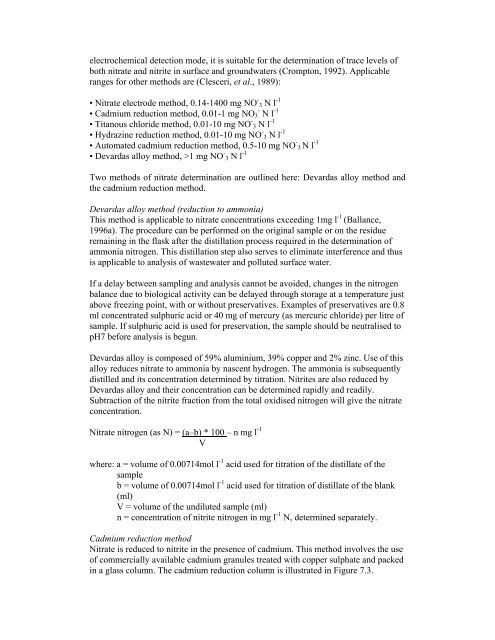Rolling Revision of the WHO Guidelines for Drinking-Water Quality ...
Rolling Revision of the WHO Guidelines for Drinking-Water Quality ...
Rolling Revision of the WHO Guidelines for Drinking-Water Quality ...
Create successful ePaper yourself
Turn your PDF publications into a flip-book with our unique Google optimized e-Paper software.
electrochemical detection mode, it is suitable <strong>for</strong> <strong>the</strong> determination <strong>of</strong> trace levels <strong>of</strong><br />
both nitrate and nitrite in surface and groundwaters (Crompton, 1992). Applicable<br />
ranges <strong>for</strong> o<strong>the</strong>r methods are (Clesceri, et al., 1989):<br />
• Nitrate electrode method, 0.14-1400 mg NO - 3 N l -1<br />
• Cadmium reduction method, 0.01-1 mg NO3 - N l -1<br />
• Titanous chloride method, 0.01-10 mg NO - 3 N l -1<br />
• Hydrazine reduction method, 0.01-10 mg NO - 3 N l -1<br />
• Automated cadmium reduction method, 0.5-10 mg NO - 3 N l -1<br />
• Devardas alloy method, >1 mg NO - 3 N l -1<br />
Two methods <strong>of</strong> nitrate determination are outlined here: Devardas alloy method and<br />
<strong>the</strong> cadmium reduction method.<br />
Devardas alloy method (reduction to ammonia)<br />
This method is applicable to nitrate concentrations exceeding 1mg l -1 (Ballance,<br />
1996a). The procedure can be per<strong>for</strong>med on <strong>the</strong> original sample or on <strong>the</strong> residue<br />
remaining in <strong>the</strong> flask after <strong>the</strong> distillation process required in <strong>the</strong> determination <strong>of</strong><br />
ammonia nitrogen. This distillation step also serves to eliminate interference and thus<br />
is applicable to analysis <strong>of</strong> wastewater and polluted surface water.<br />
If a delay between sampling and analysis cannot be avoided, changes in <strong>the</strong> nitrogen<br />
balance due to biological activity can be delayed through storage at a temperature just<br />
above freezing point, with or without preservatives. Examples <strong>of</strong> preservatives are 0.8<br />
ml concentrated sulphuric acid or 40 mg <strong>of</strong> mercury (as mercuric chloride) per litre <strong>of</strong><br />
sample. If sulphuric acid is used <strong>for</strong> preservation, <strong>the</strong> sample should be neutralised to<br />
pH7 be<strong>for</strong>e analysis is begun.<br />
Devardas alloy is composed <strong>of</strong> 59% aluminium, 39% copper and 2% zinc. Use <strong>of</strong> this<br />
alloy reduces nitrate to ammonia by nascent hydrogen. The ammonia is subsequently<br />
distilled and its concentration determined by titration. Nitrites are also reduced by<br />
Devardas alloy and <strong>the</strong>ir concentration can be determined rapidly and readily.<br />
Subtraction <strong>of</strong> <strong>the</strong> nitrite fraction from <strong>the</strong> total oxidised nitrogen will give <strong>the</strong> nitrate<br />
concentration.<br />
Nitrate nitrogen (as N) = (a–b) * 100 – n mg l -1<br />
V<br />
where: a = volume <strong>of</strong> 0.00714mol l -1 acid used <strong>for</strong> titration <strong>of</strong> <strong>the</strong> distillate <strong>of</strong> <strong>the</strong><br />
sample<br />
b = volume <strong>of</strong> 0.00714mol l -1 acid used <strong>for</strong> titration <strong>of</strong> distillate <strong>of</strong> <strong>the</strong> blank<br />
(ml)<br />
V = volume <strong>of</strong> <strong>the</strong> undiluted sample (ml)<br />
n = concentration <strong>of</strong> nitrite nitrogen in mg l -1 N, determined separately.<br />
Cadmium reduction method<br />
Nitrate is reduced to nitrite in <strong>the</strong> presence <strong>of</strong> cadmium. This method involves <strong>the</strong> use<br />
<strong>of</strong> commercially available cadmium granules treated with copper sulphate and packed<br />
in a glass column. The cadmium reduction column is illustrated in Figure 7.3.

















